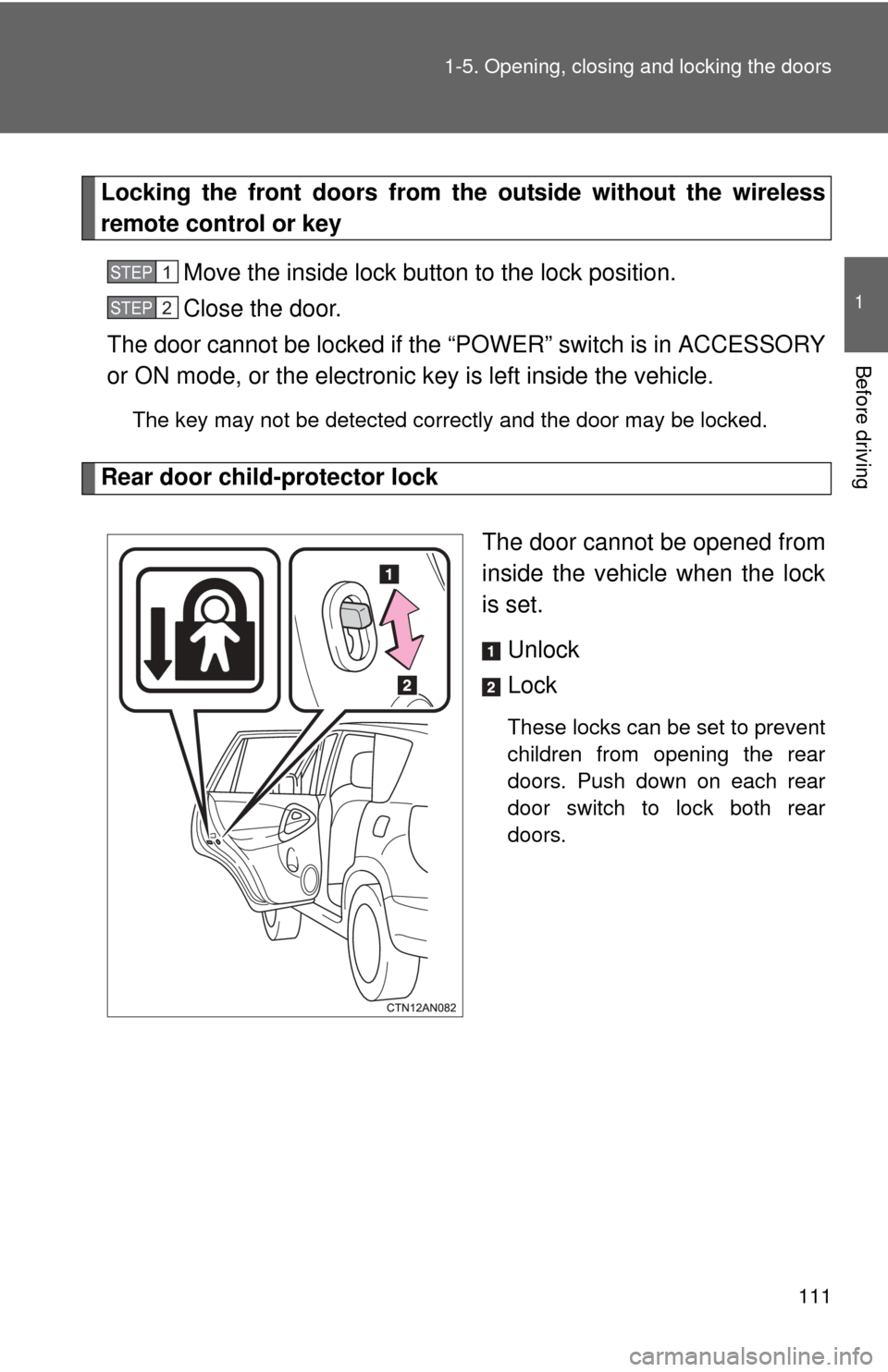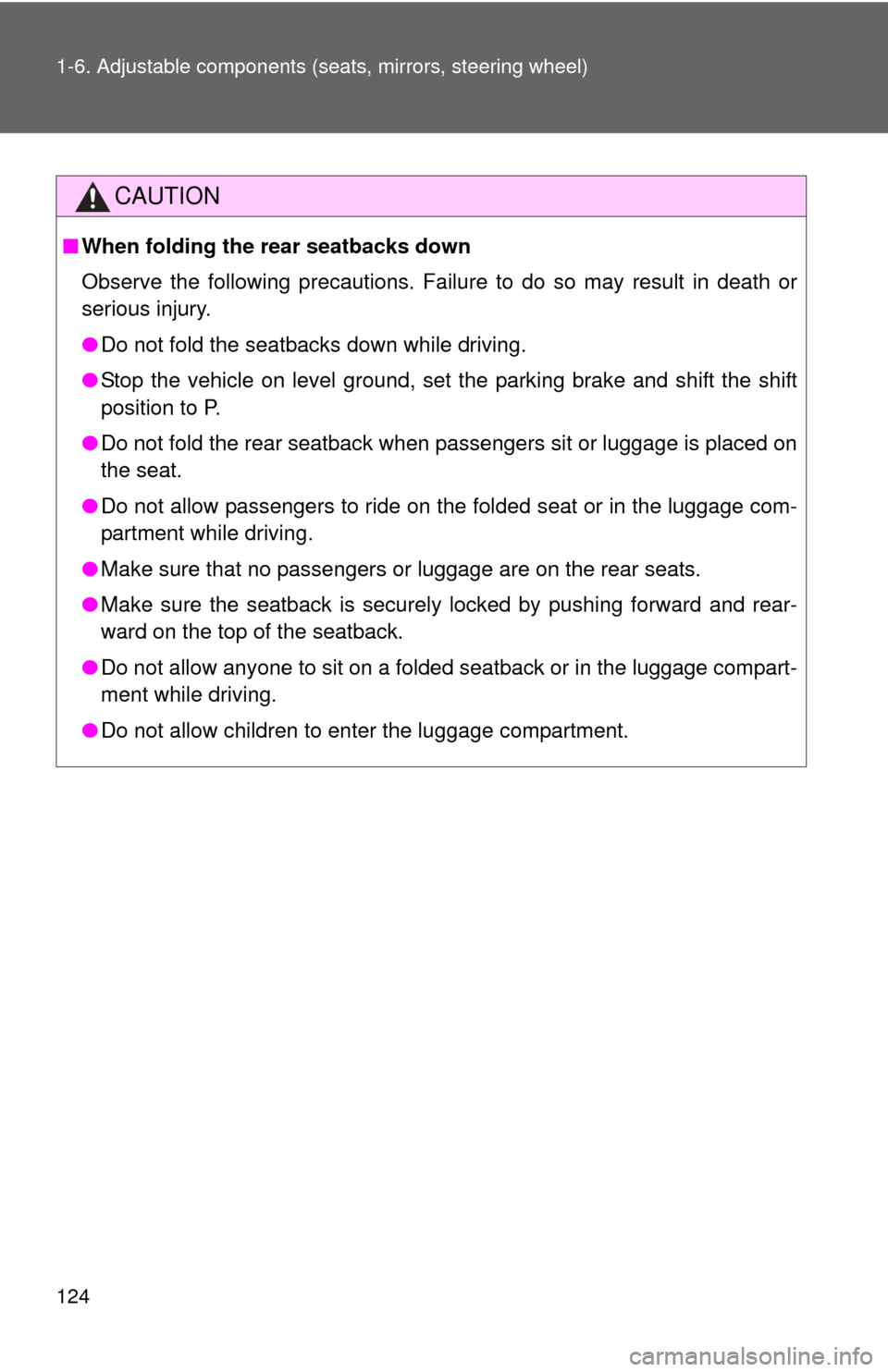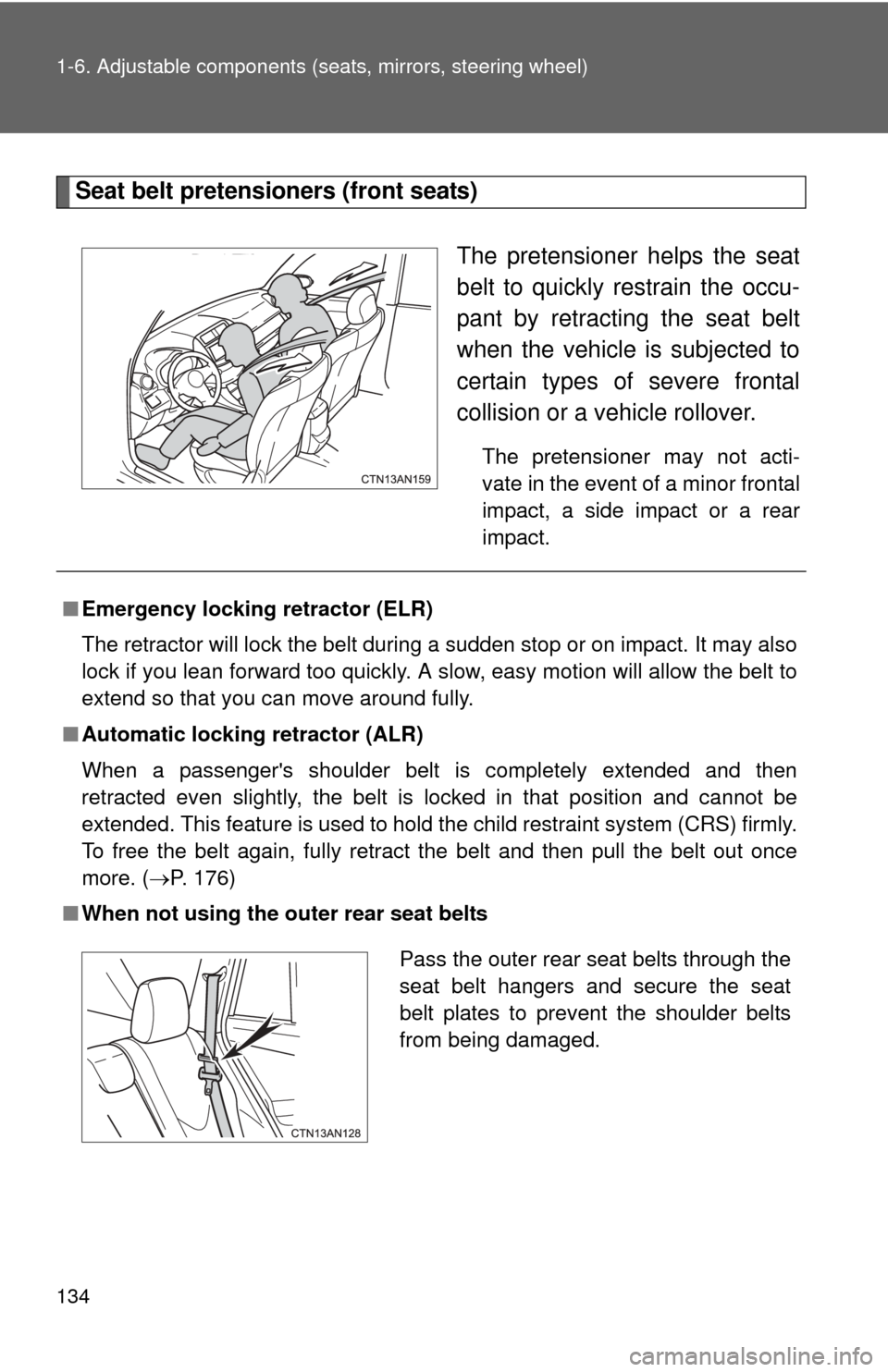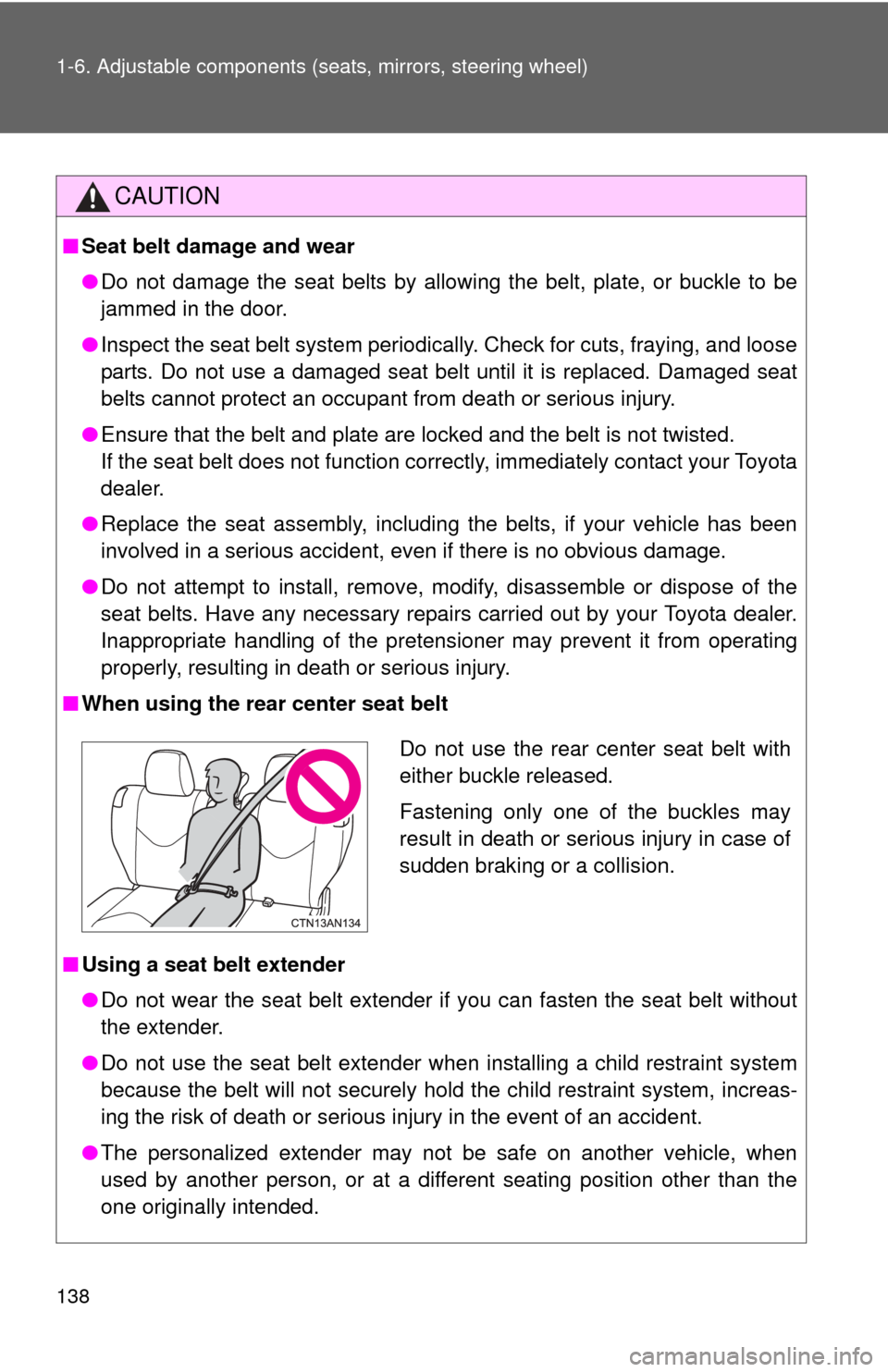2013 TOYOTA RAV4 EV child lock
[x] Cancel search: child lockPage 2 of 520

TABLE OF CONTENTSIndex
2
1-1. EV systemCharacteristics of the EV (Electric Vehicle) system .... 26
EV (Electric Vehicle) system precautions ............ 32
Energy monitor/ consumption screen ........... 38
EV (Electric Vehicle) driving tips .......................... 41
1-2. Navigation system screen operations
Navigation system screen operations .......................... 44
1-3. Charging Charging equipment ............. 46
Power sources that can be used .............................. 50
Charging and pre-climate (Remote Climate Control)
procedures ......................... 53
When normal charging cannot be carried out ......... 88
Inspecting the charging cable .................................. 92
1-4. Key information Keys ..................................... 94 1-5. Opening, closing and
locking the doors
Smart key system ................. 96
Wireless remote control ...... 108
Side doors .......................... 110
Back door ........................... 113
1-6. Adjustable components (seats, mirrors,
steering wheel)
Front seats.......................... 118
Rear seats .......................... 121
Head restraints ................... 127
Seat belts............................ 131
Steering wheel .................... 140
Anti-glare inside rear view mirror ........................ 141
Outside rear view mirrors ... 143
1-7. Opening and closing the windows
Power windows................... 146
1-8. Theft deterrent system Immobilizer system ............. 149
Theft prevention labels ....... 151
1-9. Safety information Correct driving posture ....... 152
SRS airbags ....................... 154
Front passenger occupant classification system ......... 166
Child restraint systems ....... 172
Installing child restraints ..... 176
1Before driving
Page 25 of 520

Before driving1
25
1-1. EV systemCharacteristics of the EV (Electric Vehicle)
system ............................. 26
EV (Electric Vehicle) system precautions .......... 32
Energy monitor/ consumption screen......... 38
EV (Electric Vehicle) driving tips........................ 41
1-2. Navigation system screen operations
Navigation system screen operations ........................ 44
1-3. Charging Charging equipment........... 46
Power sources that can be used ............................ 50
Charging and pre-climate (Remote Climate Control)
procedures ....................... 53
When normal charging cannot be carried out ....... 88
Inspecting the charging cable ................................ 92
1-4. Key information Keys ................................... 94
1-5. Opening, closing and locking the doors
Smart key system .............. 96 Wireless remote control ... 108
Side doors ........................ 110
Back door ......................... 113
1-6. Adjustable components (seats, mirrors,
steering wheel)
Front seats ....................... 118
Rear seats........................ 121
Head restraints................. 127
Seat belts ......................... 131
Steering wheel ................. 140
Anti-glare inside rear view mirror ..................... 141
Outside rear view mirrors ............................ 143
1-7. Opening and closing the windows
Power windows ................ 146
1-8. Theft deterrent system Immobilizer system .......... 149
Theft prevention labels..... 151
1-9. Safety information Correct driving posture..... 152
SRS airbags ..................... 154
Front passenger occupant classification system ...... 166
Child restraint systems..... 172
Installing child restraints ........................ 176
Page 111 of 520

111
1-5. Opening, closing and locking the doors
1
Before driving
Locking the front doors from the outside without the wireless
remote control or key
Move the inside lock button to the lock position.
Close the door.
The door cannot be locked if the “P OWER” switch is in ACCESSORY
or ON mode, or the electronic key is left inside the vehicle.
The key may not be detected correctly and the door may be locked.
Rear door child-protector lock
The door cannot be opened from
inside the vehicle when the lock
is set. Unlock
Lock
These locks can be set to prevent
children from opening the rear
doors. Push down on each rear
door switch to lock both rear
doors.
STEP 1
STEP 2
Page 112 of 520

112 1-5. Opening, closing and locking the doors
■Using the mechanical key
The doors can also be locked and unlocked with the mechanical key.
(P. 468)
■ When all the doors are locked with the entry function, wireless remote
control or key
The doors cannot be unlocked with the door lock switch.
The door lock switch can be reset by unlocking all the doors with the entry
function, wireless remote control or key.
■ The doors cannot be locked when
The “POWER” switch is in ACCESSORY or ON mode, or the electronic key
is left inside the vehicle.
Depending on the position of the electronic key, the key may not be detected
correctly and the door may be locked.
■ Customization that can be co nfigured at Toyota dealer
Settings (e.g. door unlocking function) can be changed.
(Customizable features P. 500)
CAUTION
■To prevent an accident
Observe the following precautions while driving the vehicle.
Failure to do so may result in a door opening and an occupant falling out,
resulting in death or serious injury.
●Always use a seat belt.
● Always lock all the doors.
● Ensure that all doors are properly closed.
● Do not pull the inside handle of the doors while driving.
The doors may be opened and the passengers are thrown out of the vehi-
cle and it may result in serious injury or death.
Be especially careful for the front doors, as the doors may be opened even
if the inside lock buttons are in locked position.
● Set the rear door child-protector locks when children are seated in the rear
seats.
Page 115 of 520

115
1-5. Opening, closing and locking the doors
1
Before driving
CAUTION
■
Caution while driving
●Keep the back door closed while driving.
If the back door is left open, it may hit near-by objects while driving or lug-
gage may be unexpectedly thrown out, causing an accident.
● Before driving the vehicle, make sure that the back door is fully closed. If
the back door is not fully closed, it may open unexpectedly while driving,
causing an accident.
● Never let anyone sit in the luggage compartment. In the event of sudden
braking or a collision, they are susceptible to death or serious injury.
● Do not get on the rear step bumper.
■ Caution while parking
If the open back door hides the stop, tail or rear turn signal lights, other road
users must be warned of the presence of your vehicle by a warning triangle
or other device.
■ When children are in the vehicle
Observe the following precautions.
Failure to do so may result in death or serious injury.
●Do not allow children to play in the luggage compartment.
If a child is accidentally locked in the luggage compartment, they could
have heat exhaustion or other injuries.
● Do not allow a child to open or close the back door.
Doing so may cause the back door to move unexpectedly, or cause the
child’s hands, head, or neck to be caught by the closing back door.
Page 124 of 520

124 1-6. Adjustable components (seats, mirrors, steering wheel)
CAUTION
■When folding the rear seatbacks down
Observe the following precautions. Failure to do so may result in death or
serious injury.
●Do not fold the seatbacks down while driving.
● Stop the vehicle on level ground, set the parking brake and shift the shift
position to P.
● Do not fold the rear seatback when passengers sit or luggage is placed on
the seat.
● Do not allow passengers to ride on the folded seat or in the luggage com-
partment while driving.
● Make sure that no passengers or luggage are on the rear seats.
● Make sure the seatback is securely locked by pushing forward and rear-
ward on the top of the seatback.
● Do not allow anyone to sit on a folded seatback or in the luggage compart-
ment while driving.
● Do not allow children to enter the luggage compartment.
Page 134 of 520

134 1-6. Adjustable components (seats, mirrors, steering wheel)
Seat belt pretensioners (front seats)
The pretensioner helps the seat
belt to quickly restrain the occu-
pant by retracting the seat belt
when the vehicle is subjected to
certain types of severe frontal
collision or a vehicle rollover.
The pretensioner may not acti-
vate in the event of a minor frontal
impact, a side impact or a rear
impact.
■Emergency locking retractor (ELR)
The retractor will lock the belt during a sudden stop or on impact. It may also
lock if you lean forward too quickly. A slow, easy motion will allow the belt to
extend so that you can move around fully.
■ Automatic locking retractor (ALR)
When a passenger's shoulder belt is completely extended and then
retracted even slightly, the belt is locked in that position and cannot be
extended. This feature is used to hold the child restraint system (CRS) firmly.
To free the belt again, fully retract the belt and then pull the belt out once
more. ( P. 176)
■ When not using the ou ter rear seat belts
Pass the outer rear seat belts through the
seat belt hangers and secure the seat
belt plates to prevent the shoulder belts
from being damaged.
Page 138 of 520

138 1-6. Adjustable components (seats, mirrors, steering wheel)
CAUTION
■Seat belt damage and wear
●Do not damage the seat belts by allowing the belt, plate, or buckle to be
jammed in the door.
● Inspect the seat belt system periodically. Check for cuts, fraying, and loose
parts. Do not use a damaged seat belt until it is replaced. Damaged seat
belts cannot protect an occupant from death or serious injury.
● Ensure that the belt and plate are locked and the belt is not twisted.
If the seat belt does not function correctly, immediately contact your Toyota
dealer.
● Replace the seat assembly, including the belts, if your vehicle has been
involved in a serious accident, even if there is no obvious damage.
● Do not attempt to install, remove, modify, disassemble or dispose of the
seat belts. Have any necessary repairs carried out by your Toyota dealer.
Inappropriate handling of the pretensioner may prevent it from operating
properly, resulting in death or serious injury.
■ When using the rear center seat belt
■ Using a seat belt extender
●Do not wear the seat belt extender if you can fasten the seat belt without
the extender.
● Do not use the seat belt extender when installing a child restraint system
because the belt will not securely hold the child restraint system, increas-
ing the risk of death or serious injury in the event of an accident.
● The personalized extender may not be safe on another vehicle, when
used by another person, or at a different seating position other than the
one originally intended.
Do not use the rear center seat belt with
either buckle released.
Fastening only one of the buckles may
result in death or serious injury in case of
sudden braking or a collision.